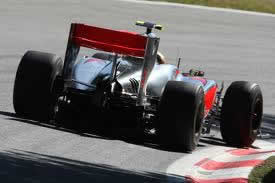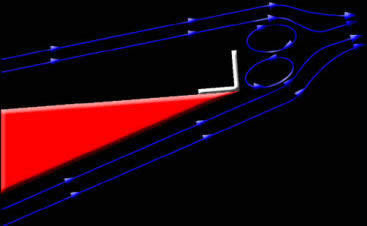Set-up of Aero components
Aerodynamics/Wings
This elements are the most influential element of your setup. Much of the design budget is devoted towards shaping airflow over, under and around the car. Not only is airflow crucial in generating downforce with the lowest possible drag coefficient, but also serves to cool several systems including brakes, engine, KERS and transmission. The most often adjusted aerodynamic aids (at a Grand Prix circuit) are the front and rear wings and car ride-height, with the rest of the aero set-up being fixed and only modifiable in the long term through wind tunnel testing. Normally, teams develop 3 types of wings. Low Medium and High downforce wings. These refer to the number of elements on each wings and general angle of attack of aerofoil.
When a team sets their car up, they first run a computer simulation, to determine which is downforce level - ie cornering grip - against straight-line speed. They get the two lines to cross each other so they have the perfect compromise - and then err slightly on the side of straight-line speed. That's because they know they will always have the speed on the straights, whereas the driver will not always get the cornering speed out of that little bit of extra downforce.
 Dealing with the aero set-up, the driver will require the car to be balanced to a certain point. He may like to drive with the centre of gravity in a certain position, which will generally be a bit different to his team mate. The front and rear wings provide massive downforce at each end of the car, and each one can be altered to vary the amount of force it produces.
Dealing with the aero set-up, the driver will require the car to be balanced to a certain point. He may like to drive with the centre of gravity in a certain position, which will generally be a bit different to his team mate. The front and rear wings provide massive downforce at each end of the car, and each one can be altered to vary the amount of force it produces.
The complexities of aerodynamics allow the engineers to get a different force from the same wing by adjusting angle of attack on each aerofoil. Wing has two defining measurements, the chord, and the span, with the cross section which defining the final shape. After the design of the wing, the angle of the chord to the oncoming airflow - called the angle of attack - defines how much force it will produce. At zero angle of attack, the wing will produce downforce, because of its shape to have a longer distance underneath than over the top, as explained in Bernoulli equation. However, if its angle is inclined (the rear of the wing raised), it will produce more and more downforce as the angle increases, up to about fifteen degrees. Around this point (depending on wing design), the air gives up, separates from the underside surface, stall, and the downforce produced will decrease if not disappear completely. By varying the angle of attack up to that point, the engineer can fine tune the car.
The front wing is generally made up of two parts - the main plane, and one or more flaps. The main plane is the part which creates the main bulk of the wing assembly's downforce, and is, almost always, at a fixed angle of attack. The fine-tuning comes from the flap. The flap is still an aerofoil, and works like one. In traveling over the main plane, the air loses energy and struggles to continue following the surface, but a gap left between the flap and the main plane allows new air to come in and re-energize the flow. With this help, it can carry on working a little longer, and create more downforce as it travels over the flap. Varying amounts of downforce can be obtained by changing the flap angle, and it is the half degree 'turns' of angle on this flap which are used to balance the car - it is designed to be so simple to change, it can be changed without losing time during a pit stop with simple screwdriver like tool.
At the rear of the car, teams design sets of rear wing elements - most have around three different options. These are built up of two aerofoils. The whole element can be changed, or angle of each aerofoil changed, to obtain the amount of downforce required. An aero map will be produced in the wind tunnel for each type of wing assembly, and taken to the circuit by the race engineer. This tells him the most efficient way of obtaining a certain level of downforce using the wing elements he has. If the driver wants more downforce on the rear, it shows him how best to achieve it, and then what angle of flap is required on the front wing to balance this change. It's all there on paper!
 The final aerodynamic change which can be made is the addition of the gurney flap. This is a small length of carbon fiber (often only 15-20mm high) which sits perpendicular to the surface at the rear of the flap (or wing on the rear wing set-up). Providing its height is correct, the air will flow over it, and become turbulent directly behind. This turbulence is flowing in higher speed, what mean that is low in pressure, and will have the effect of sucking the air out from underside of the wing. In doing this, the air will flow faster under the wing, and so will be at a lower pressure than normal, and the downforce produced by the wing will increase.
The final aerodynamic change which can be made is the addition of the gurney flap. This is a small length of carbon fiber (often only 15-20mm high) which sits perpendicular to the surface at the rear of the flap (or wing on the rear wing set-up). Providing its height is correct, the air will flow over it, and become turbulent directly behind. This turbulence is flowing in higher speed, what mean that is low in pressure, and will have the effect of sucking the air out from underside of the wing. In doing this, the air will flow faster under the wing, and so will be at a lower pressure than normal, and the downforce produced by the wing will increase.
What is important to know about the wings is that they represent your aero grip. Aero grip is just part of the overall grip. There is also mechanical grip. Aero grip comes from the wings, diffuser and the ride height. The relationship between the two types of grip varies according to your speed. It is said that at maximum speed, an F1 car produces 5 g's of downforce! 5 times its weight pressing it down onto the track. At lower speeds, the wings are not quite as important, and in this case mechanical grip (geometry, tires and suspension) is more important. So it is important to have both mechanical and aerodynamic grip optimized.
Ride height (rear diffuser)
Ride height is a kind of mix of aero and mechanical set-up. With changes in mechanical "department" we can gain on aero.
Airflow underneath the car is another source of downforce, particularly at the rear of the car. The airflow close to the ground is channeled under and around the plank. This airflow, due to the small gap between the car and road is highly pressurized from its "venturi" effect. From here, the air is accelerated by means of the rear diffuser. The diffuser design calculates the amount of space underneath the car, then sculpts an exit of increasing spatial volume. Much like an aircraft wing creates lift from low pressure by accelerating airflow over its tapered surface, the diffuser creates this low-pressure acceleration at the rear of the car, and in the opposite direction, as the undercar airflow is literally pulled out from underneath. This suction causes pressure drop and downforce without any drag penalty. Therefore it's very, very efficient. This low-pressure downforce increases as the ride height decreases. This is why we want to run the car as low to the ground as possible without drastically affecting plank wear. Ride height is initially dictated by spring rates, which themselves are selected for handling characteristics. Then the cars rideheight is fine-tuned by the ride-height adjustments on the suspension push rods. Also, check my separate article about car rake angle.
Brake and engine cooling
Brakes require air for cooling at the cost of upsetting the airflow around the car and creating drag. Inside and slightly ahead of each hub/wheel assembly, are the brakes cooling ducts. These ducts are necessary to force cool air over the brake discs. They come in seven variations in size. These openings can be made larger or smaller depending on the circuit and external temperature. The smaller the inlet,the less drag is created as airflow is allowed to pass along the cars body.
As we can see, deciding the right setup is long process with a lot of tries and mistakes. Compromising is very important to reach the perfect setup and is very hard to reach this "perfect".
Now, to learn more about other specific parts of set-up, please follow this links:
- Set-up in general
- Set-up of mechanical components and their interactions
- Set-up for specific track characteristics
- Set-up for wet track
To have a complete picture of performance driving, take a look at Corners, Setup, Traction circle, Using tires, Left foot braking, braking, advanced braking, WRC braking technique, Slipstreaming, drifting, cornering, shifting, Heel and toe driving technique and steering technique articles.






